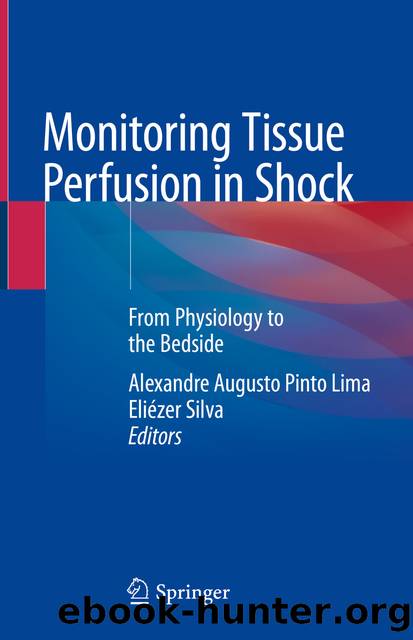Monitoring Tissue Perfusion in Shock by Alexandre Augusto Pinto Lima & Eliézer Silva

Author:Alexandre Augusto Pinto Lima & Eliézer Silva
Language: eng
Format: epub
Publisher: Springer International Publishing, Cham
Correct positioning of the CVC should be with its tip in the SVC, below the anterior first rib and above the RA [159]. On the chest radiograph, the CVC tip should lie slightly above the carina [160], placing it just below the opening of the azygos vein, a unilateral vessel carrying blood from the posterior intercostal muscle and diaphragmatic veins. The outlet of the infrared spectrophotometer fiber-optic lumen, where ScvO2 is measured, is also located at the CVC tip.
Patients in the EGDT study developed severe metabolic acidosis. They also experienced considerable respiratory distress, with 53% requiring invasive mechanical ventilation, compared to 26%, 20%, and 22% for patients in the ProCESS, ARISE, and ProMISe trials, respectively. Compensatory ventilation, with the concomitant increased work by respiratory muscles, particularly by the intercostal muscles, may have led to the azygos vein discharging venous blood of very low O2 saturation into the SVC, in close proximity to the CVC tip. Therefore, the low ScvO2 values reported in the EGDT trial possibly reflected increased work of breathing, not global tissue hypoxia. In that instance, the indicated therapy was mechanical ventilation, not RBC transfusion or dobutamine infusion. Supporting this hypothetical series of events is a study in septic patients showing increases in ScvO2 from 64 to 71% before and after emergent intubation and institution of mechanical ventilation [161].
In summary, ScvO2-guided resuscitation does not improve the survival of septic patients. This does not mean that therapy grounded on the early treatment of septic patients is futile. The early application of some treatment modalities, such as low tidal volume mechanical ventilation [162] and rapid fluid infusion with reversal of hypotension [163] may improve survival in severe sepsis or septic shock.
Download
This site does not store any files on its server. We only index and link to content provided by other sites. Please contact the content providers to delete copyright contents if any and email us, we'll remove relevant links or contents immediately.
| Anesthesiology | Colon & Rectal |
| General Surgery | Laparoscopic & Robotic |
| Neurosurgery | Ophthalmology |
| Oral & Maxillofacial | Orthopedics |
| Otolaryngology | Plastic |
| Thoracic & Vascular | Transplants |
| Trauma |
When Breath Becomes Air by Paul Kalanithi(7264)
Why We Sleep: Unlocking the Power of Sleep and Dreams by Matthew Walker(5642)
Paper Towns by Green John(4169)
The Immortal Life of Henrietta Lacks by Rebecca Skloot(3826)
The Sports Rules Book by Human Kinetics(3588)
Dynamic Alignment Through Imagery by Eric Franklin(3489)
ACSM's Complete Guide to Fitness & Health by ACSM(3469)
Kaplan MCAT Organic Chemistry Review: Created for MCAT 2015 (Kaplan Test Prep) by Kaplan(3423)
Introduction to Kinesiology by Shirl J. Hoffman(3301)
Livewired by David Eagleman(3122)
The River of Consciousness by Oliver Sacks(2992)
Alchemy and Alchemists by C. J. S. Thompson(2911)
The Death of the Heart by Elizabeth Bowen(2901)
Descartes' Error by Antonio Damasio(2731)
Bad Pharma by Ben Goldacre(2730)
Kaplan MCAT Behavioral Sciences Review: Created for MCAT 2015 (Kaplan Test Prep) by Kaplan(2492)
The Gene: An Intimate History by Siddhartha Mukherjee(2491)
The Fate of Rome: Climate, Disease, and the End of an Empire (The Princeton History of the Ancient World) by Kyle Harper(2436)
The Emperor of All Maladies: A Biography of Cancer by Siddhartha Mukherjee(2431)
